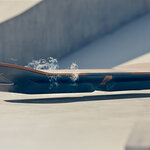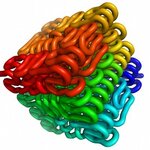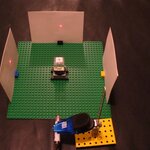Applied Physics
I’ll demonstrate how I built a very simple panoramic mount out of Lego for your various Lego optics lab lens and filter holders.
Follow me on Twitter: @SteveSchuler20.
Parts needed
1 Lego turntable 4 X 4
2 Lego Beams 1 X 4
Here’s how I built my Lego simple panoramic mount.
I mounted my Lego mirror/filter holder to demonstrate how to use the Lego Optics Lab: Panoramic Mount.

Donuts, electric current and quantum physics - if you are a theoretical physicist interested in topological insulators, materials whose ability to conduct electric current originates in their topology, it makes perfect sense.
The easiest way to understand what "topological" means in this context is to imagine how a donut can be turned into a coffee cup by pulling, stretching and moulding - but without cutting it.
Topologically speaking, therefore, doughnuts and coffee cups are identical, and by applying the same principle to the quantum mechanical wave function of electrons in a solid one…
I’ll demonstrate how I built a simple mirror or filter mount out of Lego. This mount can then be attached to a pan and/or tilt mechanism.
Follow me on Twitter: @SteveSchuler20.
Also see my previous article to see how I built a large lens holder for my Lego optics lab.
Parts needed
1 Plate 2 X 8
2 Technic Beams 1 X 2
2 Arm section with pin and two fingers
Here’s how I built my Lego mirror/filter holder:

By Michael Greshko, Inside Science - In the classic 1989 film Back to the Future 2, intrepid time traveler Marty McFly jumps ahead a few decades, to October 21, 2015.
Luxury car manufacturer Lexus appears to be ready for him. This week, they announced that they've built a "real, rideable" hoverboard.
They've even released video of it, oozing fog and mysteriously floating over what looks like a concrete sidewalk. Check out the 38-second teaser for yourself:
Great Scott!
Of course, McFly might be disappointed to learn he can't buy it; Lexus has no plans to sell the prototype board, Ars…
For my Lego Optics Lab I have so far built a beam splitter, and a small lens holder. The beam splitter article got a link on io9 (my name is misspelled) and on Scientific American. The small lens holder also got a link on Scientific American.
Among the lenses I salvaged from the computer projector was a larger double concave lens. I decided to use the same lens holder design for the concave lens that I built for the smaller lenses including the same shock absorber brick. It holds the concave lens just as well as the smaller lenses and the holder only had to be a bit larger to fit the…
In my previous article, I started building a Lego optics lab with a dichroic prism I salvaged from an old computer projector that I took apart (I used the prism to build a beam splitter). I also salvaged several lenses, mirrors, and filters. To continue the Lego Optics Lab project I’ll demonstrate how I built a lens holder for the several small lenses from the projector. My lens holder uses mostly standard Lego parts except for the shock absorber brick.
The reason I used this brick is that I was a bit concerned that some of the lenses seem fairly thin and fragile. The spring is weak…

A lot of problems, associated with the mixing of the liquid in the microchannels, could be solved via proper organization of the inhomogeneous slip on the walls of these channels, according to a joint group of Russian and German scientists lead by Olga Vinogradova, professor at the M.V. Lomonosov Moscow State University.
The work is related to the field of microfluidics, studying the fluid flow in the microchannels, which is essential in chemistry and biomedical research where there is a necessity to carry out chemical synthesis of small doses of substance or to perform separation of…

I finally took apart a broken computer projector. Some of the optics were burned or broken but I managed to salvage several lenses, mirrors, filters, and a curious little glass cube.
On three sides of the cube were attached tiny LCD screens. It seemed then that the little cube was a beam splitter, or rather, the reverse of a beam splitter that combined the images from the three LCD screens to be projected onto a big projection screen. It is called a “dichroic prism.” You can learn more about how computer projectors work here.
There were three filters glued to the faces of the…
I've talked before about how life on present day Mars could be vulnerable to Earth life. If only humans could be sterilized of other life, like a plant seed. But sadly, we can't do that, and it would kill us to try. Recent ideas, and experiments in Mars simulation chambers suggest that there may be liquid water habitats on the surface of Mars. They may be no more than droplets of water a few millimeters in diameter, but these still are, as Nilton Renno said, "Swimming pools for a microbe". And humans can't go anywhere without taking hundreds of trillions of microbe hitchhikers along with us…

A team of engineers have created tiny acoustic vortices and used them to grip and spin microscopic particles suspended in water.
The research by academics from the University of Bristol's Department of Mechanical Engineering and Northwestern Polytechnical University in China, is published in Physical Review Letters. The researchers have shown that acoustic vortices act like tornados of sound, causing microparticles to rotate and drawing them to the vortex core. Like a tornado, what happens to the particles depends strongly on their size.
Bruce Drinkwater, Professor of Ultrasonics in the…